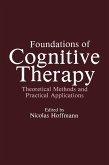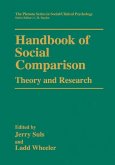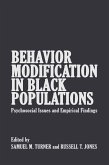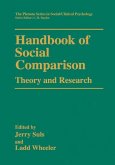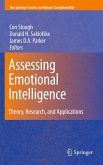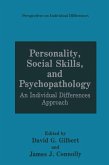Assessment and Modification of Emotional Behavior
Herausgegeben von Blankstein, Kirk R.
Assessment and Modification of Emotional Behavior
Herausgegeben von Blankstein, Kirk R.
- Broschiertes Buch
Andere Kunden interessierten sich auch für
![Foundations of Cognitive Therapy Foundations of Cognitive Therapy]() Foundations of Cognitive Therapy39,99 €
Foundations of Cognitive Therapy39,99 €![Handbook of Social Comparison Handbook of Social Comparison]() Handbook of Social Comparison164,99 €
Handbook of Social Comparison164,99 €![Behavior Modification in Black Populations Behavior Modification in Black Populations]() Behavior Modification in Black Populations39,99 €
Behavior Modification in Black Populations39,99 €![Handbook of Social Comparison Handbook of Social Comparison]() Jerry Suls / Ladd Wheeler (eds.)Handbook of Social Comparison154,99 €
Jerry Suls / Ladd Wheeler (eds.)Handbook of Social Comparison154,99 €![Values, Achievement, and Justice Values, Achievement, and Justice]() Norman T. FeatherValues, Achievement, and Justice115,99 €
Norman T. FeatherValues, Achievement, and Justice115,99 €![Assessing Emotional Intelligence Assessing Emotional Intelligence]() Con Stough / Donald H. Saklofske / James D.A. Parker (ed.)Assessing Emotional Intelligence174,99 €
Con Stough / Donald H. Saklofske / James D.A. Parker (ed.)Assessing Emotional Intelligence174,99 €![Personality, Social Skills, and Psychopathology Personality, Social Skills, and Psychopathology]() David G. Gilbert / James J. Connolly (Hgg.)Personality, Social Skills, and Psychopathology115,99 €
David G. Gilbert / James J. Connolly (Hgg.)Personality, Social Skills, and Psychopathology115,99 €-
-
-
Produktdetails
- Advances in the Study of Communication and Affect .6
- Verlag: Springer / Springer US / Springer, Berlin
- Artikelnr. des Verlages: 978-1-4684-3784-3
- Softcover reprint of the original 1st edition 1980
- Seitenzahl: 236
- Erscheinungstermin: 15. Juni 2012
- Englisch
- Abmessung: 229mm x 152mm x 13mm
- Gewicht: 349g
- ISBN-13: 9781468437843
- ISBN-10: 1468437844
- Artikelnr.: 37478490
- Herstellerkennzeichnung
- Springer-Verlag GmbH
- Tiergartenstr. 17
- 69121 Heidelberg
- ProductSafety@springernature.com
1 Measuring and Modifying Moods: An Introduction.- References.- 2 On the Paucity of Positive Emotions.- The Relative Frequency of Positive and Negative Emotional Concepts.- The Meaning of Emotional Concepts.- The Attribution of Emotion as a Function of Response Outcomes..- The Relationship between Emotional Concepts and Emotional Behavior.- Implications for the Assessment and Modification of Emotional Behavior.- References.- 3 Measurement Implications of a Psychoevolutionary Theory of Emotions.- Emotions as Inferences.- Emotions and Evolution.- Tests of Emotion-Personality.- Other Theory-Based Measures.- Summing Up.- References.- 4 To Risk or Not to Risk: Predicting Behavior from Negative and Positive Emotional States.- The Multiple Affect Adjective Check List (MAACL).- Dimensions of Affect.- Zipers State Test.- Development of a Sensation Seeking State Scale.- To Risk or Not to Risk.- Performance and Affect.- References.- 5 Detecting the Dimensions of Depression: Behavioral Assessment in Therapy Outcome Research.- Clinical Phenomena.- Assessment Methods.- The Self-Control Model of Depression.- Therapy Program.- Therapy Research.- References.- 6 Consequences of Increasing the Functional Impact of Internal Emotional Stimuli.- Increasing Functional Exposure to Phobic Imagery via Expectancy and Relaxation.- Increasing Functional Exposure to Physiological Responses via Relaxation.- Conclusion.- References.- 7 Cognitive Ethology: Assessing the Streams of Cognition and Emotion.- Cognitive Ethology.- Cognitive Assessment Following Performance.- Concurrent Cognitive Assessment.- Cognitive Assessment Preceding Performance.- Units and Levels of Analysis.- Accessibility and Accuracy of Verbal Reports.- References.- 8 Personality Differences in Decision Making under Stress.- SocialPower of Supportive Helpers.- Crises in a Helping Relationship.- Evidence on the Effects of Building Referent Power.- Level of Self-Esteem.- Field Dependence.- Theoretical Analysis of Coping Predispositions.- References.- 9 Stress, Behavior Patterns, and Coronary Disease.- Psychological Risk Factors.- Type A Behavior Pattern.- Measuring the A and B Behavior Patterns.- Interplay of Stress and Pattern A.- Control and Coronary Heart Disease.- A Proposed Biobehavioral Model.- Implications for Therapy.- References.
1 Measuring and Modifying Moods: An Introduction.- References.- 2 On the Paucity of Positive Emotions.- The Relative Frequency of Positive and Negative Emotional Concepts.- The Meaning of Emotional Concepts.- The Attribution of Emotion as a Function of Response Outcomes..- The Relationship between Emotional Concepts and Emotional Behavior.- Implications for the Assessment and Modification of Emotional Behavior.- References.- 3 Measurement Implications of a Psychoevolutionary Theory of Emotions.- Emotions as Inferences.- Emotions and Evolution.- Tests of Emotion-Personality.- Other Theory-Based Measures.- Summing Up.- References.- 4 To Risk or Not to Risk: Predicting Behavior from Negative and Positive Emotional States.- The Multiple Affect Adjective Check List (MAACL).- Dimensions of Affect.- Zipers State Test.- Development of a Sensation Seeking State Scale.- To Risk or Not to Risk.- Performance and Affect.- References.- 5 Detecting the Dimensions of Depression: Behavioral Assessment in Therapy Outcome Research.- Clinical Phenomena.- Assessment Methods.- The Self-Control Model of Depression.- Therapy Program.- Therapy Research.- References.- 6 Consequences of Increasing the Functional Impact of Internal Emotional Stimuli.- Increasing Functional Exposure to Phobic Imagery via Expectancy and Relaxation.- Increasing Functional Exposure to Physiological Responses via Relaxation.- Conclusion.- References.- 7 Cognitive Ethology: Assessing the Streams of Cognition and Emotion.- Cognitive Ethology.- Cognitive Assessment Following Performance.- Concurrent Cognitive Assessment.- Cognitive Assessment Preceding Performance.- Units and Levels of Analysis.- Accessibility and Accuracy of Verbal Reports.- References.- 8 Personality Differences in Decision Making under Stress.- SocialPower of Supportive Helpers.- Crises in a Helping Relationship.- Evidence on the Effects of Building Referent Power.- Level of Self-Esteem.- Field Dependence.- Theoretical Analysis of Coping Predispositions.- References.- 9 Stress, Behavior Patterns, and Coronary Disease.- Psychological Risk Factors.- Type A Behavior Pattern.- Measuring the A and B Behavior Patterns.- Interplay of Stress and Pattern A.- Control and Coronary Heart Disease.- A Proposed Biobehavioral Model.- Implications for Therapy.- References.


